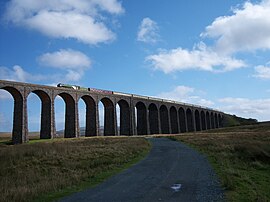Settle-Carlisle
| Settle–Carlisle line | |
|---|---|

|
|
| Overview | |
| Type | Main line |
| System | National Rail |
| Status | Operational |
| Locale |
North West England Yorkshire and the Humber |
| Termini |
Settle 54°04′01″N 2°16′51″W / 54.0669°N 2.2807°W Carlisle 54°53′28″N 2°56′01″W / 54.8911°N 2.9335°W |
| Stations | 10 |
| Services | 1 |
| Operation | |
| Opened | 1875 (goods) and 1876 (passengers) |
| Owner | Network Rail |
| Operator(s) | Northern Rail |
| Depot(s) | Neville Hill, Leeds |
| Rolling stock | Primarily Class 158 |
| Technical | |
| Line length | 71.75 mi (115.47 km) |
| Number of tracks | Double |
| Track gauge | Standard gauge 4 ft 8 1⁄2 in (1,435 mm) |
| Operating speed | 60 mph |
| Highest elevation | Ais Gill (1,169 feet (356 m)) |
The Settle–Carlisle line (also known as the Settle and Carlisle (S&C)) is a 73-mile-long (117 km) main railway line in northern England. The route, which crosses the remote, scenic regions of the Yorkshire Dales and the North Pennines, runs between Settle Junction on the Leeds to Morecambe line and Carlisle near the English-Scottish borders. The historic line was constructed in the 1870s and has several notable tunnels and viaducts such as the imposing Ribblehead.
The line is a part of the National Rail network that is managed by Network Rail. All passenger services are operated by Northern apart from those temporary diverted services (due to closures of the West Coast Main Line). Stations serve towns such as Settle in North Yorkshire and Appleby-in-Westmorland in Cumbria as well as small rural communities along its route.
In the 1980s, the Settle-Carlisle was scheduled for closure by British Rail. This prompted rail groups, enthusiasts, local authorities and residents along the route to fight a successful campaign to save the railway. In 1989 the UK government announced it had declined to close the line. Since then passenger numbers have grown steadily to 1.2 million in 2012. Eight formerly closed stations have also been reopened. Several quarries have also been reconnected to the line. It remains one of the most popular railway routes in the UK for charter trains and specials. After damage by a landslip, part of the line was closed from February 2016 to March 2017. To celebrate the reopening, the first regular mainline scheduled service in England for more than half a century ran with a steam engine.
...
Wikipedia
